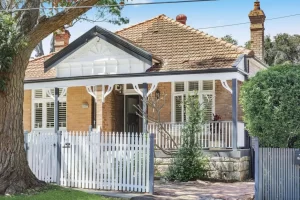Sydney house prices rose 29.6 per cent last year, adding nearly $1000 each day or a total of $359,616 in 12 months, while Canberra prices climbed by about $700 daily, in a year of extraordinary property price growth, the CoreLogic December home value index shows.
All capitals posted healthy yearly gains, but the markets have started to diverge, as poor affordability and a flood of listings dampened growth in Sydney and Melbourne, while the smaller and cheaper capitals powered ahead.
Brisbane house prices climbed 30.4 per cent or $253,292 over the year, Melbourne rose by $197,948 or a gain of 17.9 per cent and Adelaide prices increased by $117,326 – a 25.8 per cent jump during the same period.
Hobart added $195,725 or 26.7 per cent, Darwin gained $67,858 or 12.4 per cent and Perth by $62,203 or 13.3 per cent. Nationally, house prices rose by $191,505 or a 24.5 per cent increase.
Housing markets started to deviate in the last three months of the year, with Brisbane’s median dwelling values rising 8.5 per cent and Adelaide by 7.2 per cent.
By contrast, Sydney added just 2.7 per cent and Melbourne gained 1.5 per cent. Canberra lifted by 4 per cent and Hobart by 4.2 per cent. Perth rose 0.4 per cent and Darwin by 0.7 per cent over the same period.
“The divergence is just stark – you can really see Brisbane and Adelaide gathering momentum on the back of stronger demand, lower supply and better affordability, while Sydney, Melbourne and Perth are clearly losing momentum and have been doing so for some time,” said Tim Lawless, CoreLogic research director.
“I think arguably there is some element of catch-up here, but I would be surprised if these markets that are gathering momentum like Brisbane and Adelaide could continue to do so for much longer simply because they’ll also start to run into the same challenges that Sydney and Melbourne have experienced around affordability and higher listings as more vendors take advantage of the very strong, selling conditions.”
Melbourne house prices ended the year 0.2 per cent lower over the month while Sydney prices rose by just 0.4 per cent, largely underperforming Brisbane’s 3.1 per cent monthly gain and Adelaide’s 2.7 per cent growth.
“Melbourne prices may have already peaked, while Sydney prices are likely to peak by mid-year, but laggard cities like Brisbane and Adelaide and possibly Perth and Darwin which are less constrained by poor affordability are likely to be relatively stronger this year,” said Shane Oliver, AMP Capital chief economist.
Mr Lawless said it was normal for Sydney and Melbourne as well as the upper end of the market to lead the slowdown as they were further ahead in the housing cycle.
“When you look through the cycles every time, they are generally led by Sydney and Melbourne and by the top end,” he said.
“We have seen this trend in previous growth cycles, where more expensive housing markets have shown greater levels of volatility; housing values tend to rise more through the upswing but record a larger decline through the down phase of the cycle.”
Across the combined capitals, upper quartile dwelling values increased 2.6 per cent in October-December compared with a 3.7 per cent rise across the lower quartile and broad middle of the market.
Omicron a risk for sentiment
Looking ahead, Mr Lawless said surging omicron cases across the country could dent sentiment and potentially slow price growth further in the next few months.
“I think if we do start to see the surge in omicron cases impacting consumer sentiment, then that will play out as a downside risk for housing markets because we know that sentiment and housing activity are highly correlated, which isn’t surprising,” he said.
“Even if we didn’t see any policy changes related to COVID-19 restrictions such as a ban on property inspections, for example, there is still some downside element from the surging in COVID cases simply through consumer confidence being eroded.”
But the worsening virus situation could also trigger another wave of regional migration and drive home prices there even higher, said Mr Lawless.
“If we do see the pandemic becoming ongoing through the first half of this year, it probably will motivate more people to look further afield, especially as we see more and more companies implementing or formalising their hybrid working policies,” he said.
“So I think this regional trend probably has some way to go. I think the most popular regional areas and their neighbouring markets are probably going to continue to outperform through this year, as we see that demographic tailwind improving housing demand in those markets.”
In the past 12 months, dwelling prices across the combined regional areas had risen by 25.9 per cent, while the combined capitals grew by 21 per cent.
Dr Oliver said home prices were poised to grow by just 5 per cent this year and likely to fall by up to 10 per cent in 2023.
“The main risks to our forecasts are on the downside and could come from another big coronavirus setback to the economy or alternatively faster mortgage rate hikes, which is the biggest risk,” he said.
“The main risk on the upside would be a rapid surge in immigration post the federal election to make up for lost immigrants over the last two years, although this is likely to show up initially in higher rents and then higher prices with a lag.”
This article is from Australian Financial Review, please click the following link for the original article: https://www.afr.com/property/residential/sydney-house-prices-grew-1000-a-day-in-2021-20220103-p59lgx




